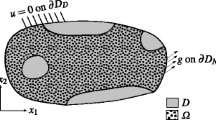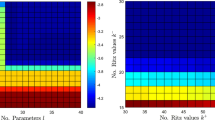Abstract
An application to structural design of an innovative method for optimising stochastic systems is introduced in the paper. The proposed method allows one to carry out both the multi-objective optimisation of a structural element and to improve the robustness of the design. The innovative method is rather general. To show its effectiveness, an ideal cantilever has been designed in order to minimise both mass and deflection. The cantilever is shaped as a beam and is subject to random loads acting at its free end. The beam geometrical dimensions and material properties vary stochastically due to manufacturing tolerances. Different beam cross sections and two different materials (aluminium alloy and steel) have been considered. From the optimisation, it turned out that the optimal solutions are the O and the I beam, depending on the required lightness and stiffness. Compared to steel, aluminium alloy beams have provided better (or at least equal) performance.
Similar content being viewed by others
References
Ballio, G.; Mazzolani, F.M. 1988: Steel structures (in Italian). Milan: Hoepli
Beretta, S.; Citti, P.; Capitani, R.; Paolini, G. 1999: Quality Reliability and Safety of Mechanical structures and Systems (in Italian). Florence: CUSL
Bjorkman, M.; Holmstrom, K. 1999: Global Optimization using the DIRECT Algorithm in MATLAB. Adv Model Optim1(2)
Caballero, R.; Cerdá, E.; Muñoz, M.M.; Rey, L.; Stancu-Minasian, I.M. 2001: Efficient Solution Concepts and Their Relations in Stochastic Multiobjective Programming. J Optim Theory Appl110(1)
Cedolin, L.; Baant, Z. 1991: Stability of Structures. New York: Oxford University Press
Chen, W.; Sahai, A.; Messac, A.; Sundararaj, G. 2000: Exploration of the Effectiveness of Physical Programming in Robust Design. J Mech Des122
Chen, W.; Wiecek, M.; Zhang, J. 1999: Quality Utility – A Compromise Programming Approach to Robust Design. J Mech Des121(2)
Clark, J.W.; Hill, H.N. 1962: Lateral Buckling of Beams and Girders. Trans ASCE127, Part II
Das, I. 1999: A preference ordering among various Pareto optimal alternatives. Struct Optim18, 30–35
DIRECT 1999: Encyclopedia of Optimization. Dordrecht: Kluwer Academic
Eggert, R.J.; Mayne, R.W. 1990: Probabilistic Optimization Using Successive Surrogate Probability Density Functions. Proceedings ASME 16thDesign Automation Conf., Chicago, IL, DE-Vol. 23–1
Emch, G.; Parkinson, A. 1993: Robust Optimal Design for Worst-Case Tolerances. Proceedings of the 1993 ASME Design Automation Conf., DE-Vol. 65–1, Albuquerque, NM
Fadel, G.; Li, Y. 2002: Approximating the Pareto curve to help solve biobjective design problems. Struct Optim23, 280–296
Gobbi, M.; Mastinu, G.; Caudano, M. 2003: Stochastic Multi-Objective Optimisation of a Gearbox Synchroniser and Selector Mechanism. In Advanced Vehicle Technologies, ASME IMECE, Washington, November 2003
Gobbi, M.; Mastinu, G. 2003: Stochastic Multi-Objective Optimisation for the Design of Vehicle Systems. Proc. of the WCSMO5, Italy, May 2003
Johnston, B.G. 1976: Guide to Stability Design Criteria for Metal Structures. NJ: Wiley
Mattson, C.A.; Messac, A. 2002: A Non-Deterministic Approach to Concept Selection Using s-Pareto Frontiers. Proc. of ASME DETC 2002, DETC2002/DAC-34125, Session DAC-17: Multiobjective Optimisation, Montreal, Canada
Mattson, C.A.; Messac, A. 2003: Concept Selection Using s-Pareto Frontiers. AIAA J41(6), 1190–1198
Messac, A.; Ismail-Yahaya, A. 2002: Multiobjective robust design using physical programming. Struct Optim23, 357–371
Miettinen, K. 1999: Nonlinear Multiobjective Optimization. Boston: Kluwer Academic
Mohandas, S.U.; Sandgren, E. 1989: Multiobjective optimization dealing with uncertainty. Proc. 15-th ASME Design Automation Conference, DE Vol. 19-2
Narayanan, S.; Azarm, S. 1999: On improving multi-objective genetic algorithms for design optimization. Struct Optim18, 146–155
Pilkey, W.D. 1994: Formulas for Stress, Strain and Structural Matrices. NJ: Wiley
Rao, S.S. 1974: A Probabilistic Approach to the Design of Gear Trains. Int J Mach Tool Des Res14
Rao, S.S. 1987: Multi-Objective Optimization of Fuzzy Structural Systems. Int J Numer Methods Eng24
Segui, W.T. 1989: Fundamentals of structural steel design. Boston: PWS-Kent
Siddal, J.N. 1984: A New Approach to Probability in Enginnering Design and Optimization. ASME J Mech Trans Autom Des106, 5–10
Siddal, J.N. 1983: Probabilistic Engineering Design: Principles and Applications. New York: Marcel Dekker
Thompson, J.M.T.; Hunt, C.W. 1974: Dangers of Structural Optimization. Eng Optim2
Yang, B.S.; Yeun, Y-S.; Ruy, W-S. 2002: Managing approximation models in multi-objective optimization. Struct Optim24, 141–156
Zhang, W.H.; Yang, H.C. 2002: Efficient gradient calculation of the Pareto optimal curve in multicriteria optimisation. Struct Optim23, 311–319
Author information
Authors and Affiliations
Corresponding author
Rights and permissions
About this article
Cite this article
Levi, F., Gobbi, M. & Mastinu, G. An application of multi-objective stochastic optimisation to structural design. Struct Multidisc Optim 29, 272–284 (2005). https://doi.org/10.1007/s00158-004-0456-2
Received:
Revised:
Published:
Issue Date:
DOI: https://doi.org/10.1007/s00158-004-0456-2




